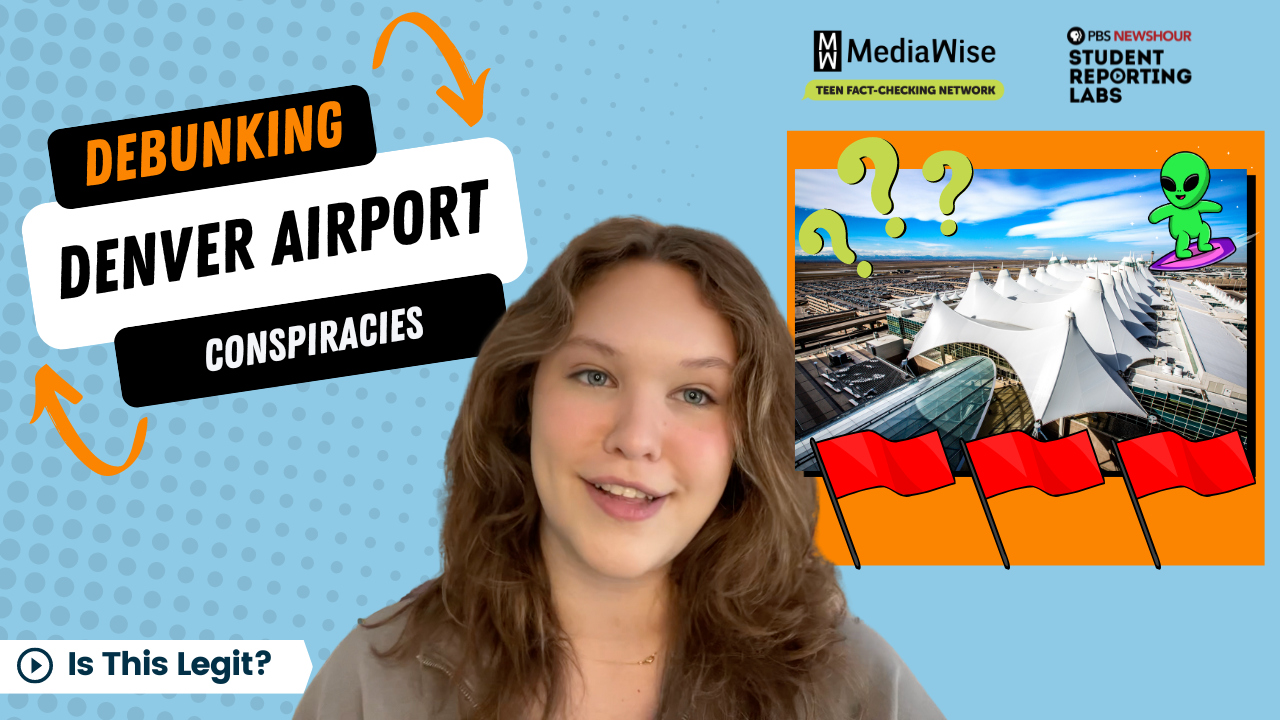Since it was built in 1995, the Denver airport has become a hotbed for conspiracy theories — scary stories about underground bunkers, murals that have coded messages about the apocalypse, runways shaped like swastikas.
One TikToker has bought into all of these stories and shared them. This is a repost of a claim that was originally made by @auntie_coolette. Despite the multitude of claims made in the video, I decided to figure out whether there is really a secret underground bunker underneath the airport. The Tiktoker says that it’s bigger than Manhattan and will be used as a safe haven for “elites” during a nuclear war or other crisis.
The best way to check out claims like this is to ask yourself these three questions from the Stanford History Education Group:
- Who is behind the information?
- What is the evidence?
- What do other sources say?
Here’s how we fact-checked it.
Who is behind the information?
Looking at @auntie_coolette’s profile, we see that they have nearly 2 million followers and post videos about religious and political topics — as well as conspiracy theories. In their bio, @aunti_coolette lists a Nevada address and links to a site that sells T-shirts, hoodies and coffee mugs. Here’s a quick tip: If someone is trying to sell you something in their bio, you always want to take another look at the videos they share. However, as we looked through their profile, it was important to note that there was nothing about them being an expert on the Denver airport.
What is the evidence?
Next, consider the evidence provided. The TikTok is filled with words like “ominous,” “illuminati” and “conspiracy.”
“These things are no coincidence,” @auntie_coolette says, with creepy music playing in the background.
But here’s the thing you quickly notice: In the whole 2-minute, 33-second video, there’s no real evidence for the claim — no links to sources, no citations. There’s just opinion, and that’s a red flag. There is no solid evidence pointing to the existence of an underground bunker.
What do other sources say?
Finally, it is critical to look at what other sources are saying. So, I did some lateral reading, a useful tool for fact-checkers. That’s when you leave the platform where you found the post, go onto any search engine, do a keyword search and open up multiple tabs to compare what other credible sources are saying about the topic.
After doing a search for “Denver airport” and “secret bunker,” this article from The Denver Post showed up, which explained the history and the facts behind all the conspiracy theories surrounding this infamous airport. The article says the conspiracy theories popped up after people got suspicious when the airport’s construction took longer and cost more than originally estimated. And it also says, yes, there are underground tunnels in the airport. But they are used to move baggage, as well as the airport’s underground trains — not to house billionaires, global elites, not even aliens.
It’s always good to check several sources, so I found this article from Insider, which interviewed airport spokesperson Alex Renteria. Renteria also said the airport has underground tunnels but there’s no big mystery. “They’re not full of conspiracy,” she said. “They’re full of baggage.”
A ‘zombie’ claim
Despite repeated debunking, Denver airport conspiracy theories have become widespread and persistent. Stubborn rumors like these that you see over and over despite having been disproven are what we call “zombie claims” — stories that never die no matter how many times you kill them. And it seems like the airport has just decided to embrace them, using the theories as a marketing strategy. They’ve even set up this humorous page on their website as well as a “museum” in the airport.
“If that’s what you want to believe, we’re not going to hinder your imagination. So dream on, travelers, dream on,” the page says.
Our rating
Not Legit. Is there a doomsday bunker underneath the Denver airport? No. Officials from the airport appear to find the theories amusing but deny any truth to them, and there is no hard evidence to show they are true.
Conspiracy theories like this can be very intriguing and honestly pretty convincing. However, they can also be very damaging if taken too far. While some suggest that the earth is flat, others can go as far as disbelieving the Holocaust.
These theories are often filled with information that isn’t backed by solid evidence, so it’s essential that we’re able to make a distinction between suspicion and fact. The bottom line: Fact-check the information first before you’re pulled completely down the rabbit hole.
NOTE TO TEACHERS: This article is featured in a free, one-hour lesson plan that teaches students how to decode a conspiracy theory using the Stanford History Education Group’s “Three Questions:” Who is behind the information? What is the evidence? And what do other sources say? The lesson is available through PBS LearningMedia, and includes a lesson summary and a handout, among other resources.






